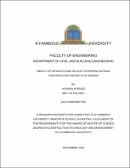Impact of design flaws on cost overruns in road Construction projects in Uganda
Abstract
The inability to complete projects within time and budget continues to be a chronic
problem worldwide and it is worsening. Cost overruns have therefore remained a major
setback in implementation of road construction projects. In Uganda, some projects have
had cost overruns to a tune of 100% and are partly attributed to design flaws. There exists
a need to understand the extent to which design flaws affect cost overruns. This research
focused on identifying design flaws encountered during the construction phase of paved
road projects and developed a model for predicting their impact on cost overruns.
A total of thirty-seven (37) design flaws encountered during construction were identified
from literature. A questionnaire survey was conducted involving 120 professionals
purposively selected from Uganda National Roads Authority, consulting firms and
contractors and were requested to rate the design flaws frequency of occurrence and
impact on cost using a five-point Likert scale basing on their experience. Using data from
16 completed paved road construction projects in Uganda, the effect of four of the major
design flaws ranked according to importance index (II) was established. Using MS Excel,
a regression model for predicting the contribution of the design flaws to cost overruns was
developed. Results indicted the major design flaws to be: provision of less number of
drainage culverts, inadequate quarries and earthen materials investigations, inadequate
geotechnical investigations for road subgrade, under estimation of quantities of rock fill
and provision of less volumes of cut and fill.
The contribution of the major design flaws to cost overrun on projects was established to
be 33.3% on average. Increase in quantity of rock fill had the biggest effect on cost
overruns with an average of 11.0% while increase in number of drainage culverts had the
least effect with an average of 6.7%. The model for predicting impact of the major design
flaws on cost overruns in paved road construction projects was developed and was found
to explain the total variations in cost overruns by 82.4%. It was concluded that most of
the design flaws which greatly affect cost overruns are attributed to non-comprehensive
geotechnical and hydrological studies.
Key words: Design Flaws, Cost overruns, Regression Model, Paved Road projects

